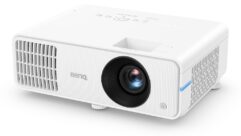

Doing Business in Higher Education
It’s a space race among the nation’s higher-education institutions to lure prospective students with, among other things, cutting-edge technology. That could be good news for AV integrators.
Several West Virginia University engineers were at the 2007 National Association of Broadcasters show when the call came in: A gunman had killed 32 Virginia Tech students and faculty and wounded 17 others. “They were told immediately to find a solution [for our school],” says George Cicci, a WVU professional technologist.
Digital signage is a key part of that solution: a network of more than 70 displays around the WVU campus. When there’s an emergency, campus police take command of the system almost instantaneously, turning the displays red to draw attention to the alert. “Our system has a nine-second response time from when the university police push the button,” Cicci says.
WVU highlights some key trends in higher education that influence market opportunities for AV pros, including how concerns over security and student safety are prompting colleges and universities to spend big on pro AV products, such as signage and video surveillance. And despite the worst economy in 70 years—one that has crimped budgets at public and private schools alike—safety-related AV is one of the few areas where spending hasn’t been drastically cut.
WVU initially deployed 10 displays as a proof of concept. Besides quickly growing sevenfold, that network also now has a permanent staff and a budget that routinely sends them to Digital Signage Expo and other events for training. “Once we proved that we had a nine-second response time with the emergency alert, the senior leadership at WVU threw every available resource behind this because they wanted everything put up quickly,” Cicci says.
Great news for AV integrators that target higher education, right? Not necessarily.
DO-IT-YOURSELF AV
WVU is also an example of how many colleges and universities are designing, installing, and managing major AV systems entirely in-house. It’s the same case at Regent University, a private college in Virginia Beach, Va., which recently completed a 45-camera IP surveillance system.
“In the early years, I used companies to do a fair amount of the outside camera work but did all the inside work myself,” says Eddie Lawhorn, who replaced Regent’s CCTV system with an IP-based platform. “The last 10 or 12 years, I’ve been able to have a staff of my own that has allowed me to handle most of that work now, too.”
TECH TRENDS HELPING DRIVE THE HIGHER-EDUCATION MARKET
- By 2014, local education agencies will reduce professional labor costs 10 percent by restructuring instructional staffing models with technology.
- By 2015, local education agencies will cut school construction in half by using virtual learning environments to better utilitze existing facilities.
- By 2014, deployment of virtualization technologies in higher-education organizations will cut desktop support costs by 20 percent.
- By 2013, 75 percent of higher-education institutions will incorporarte social software in distance-learning offerings, increasing retention in those online courses by at least 20 percent.
Source: Gartner
But by no means is the move to in-house AV sweeping the higher-education landscape. The decision between contractor and no contractor comes down to factors such as budget and the in-house personnel’s expertise. “We’re seeing a mix of in-house and going to integrators,” says Vern Freedlander, X2O Media vice president of production services.
Some AV pros say that do-it-yourselfers will have a limited product selection to choose from. “There is a growing trend in the industry by manufacturers to not sell equipment to people who have not been trained, even down to specific pieces of equipment,” says Darren Cheshier, senior design engineer at SKC Communications, a Kansas City, Kan.–based integrator. “How will colleges and universities keep up with that?”
Keeping up also applies to workload. “The in-house staffs in higher-education institutions can’t keep up with the demand,” says J. Scott Christianson, owner of Kaleidoscope Videoconferencing, a Columbia, Mo.–based integrator. “Departments are wanting to have systems installed in the next couple of weeks or months, and the in-house unit has 20 months of backlogged jobs and has to maintain the existing facilities. This alone has opened up new opportunities for integrators.”
WHERE COLLEGES AND UNIVERSITIES NEED NEW TECHNOLOGY SYSTEMS
In 2011, U.S. higher-education institutions are expected to spend $8.5 billion on new facilities, $1.1 billion on additions, and nearly $2 billion on renovations. That’s up almost 5 percent from 2010. What percentage of it is happening in your part of the country?
- New England: 7.3% (3.8% in 2010)
- New York, New Jersey, Pennsylvania: 6.9% (9% in 2010)
- Delaware, Maryland, Virginia, West Virginia, D.C.: 9.6% (6.1% in 2010)
- Kentucky, North Carolina, South Carolina, Tennessee: 13.1% (6.8% in 2010)
- Alabama, Florida, Georgia, Mississippi: 10.2% (10.7% in 2010)
- Indiana, Ohio, Michigan: 6.6% (8% in 2010)
- Illinois, Minnesota, Wisconsin: 3.1%(6.5% in 2010)
- Iowa, Kansas, Missouri, Nebraska: 1.4% (6.2% in 2010)
- Arkansas, Louisiana, Oklahoma, Texas: 11.1% (17.4% in 2010)
- Colorado, Montana, North and South Dakota, New Mexico, Utah, Wyoming: 7.7% (4.9% in 2010)
- Arizona, California, Hawaii, Nevada: 19% (17.4% in 2010)
- Alaska, Idaho, Oregon, Washington: 4.1% (3.2% in 2010)
Source: The 2011 College Construction Report, College Planning & Management
Lawhorn’s job title highlights another example of how the higher-education opportunity isn’t as straightforward as it might seem to newcomers: He’s a lieutenant in the Regent Campus Police Department. Granted, it’s not unexpected for campus cops to be involved with day-to-day operation of security- and safety-related AV systems. But some integrators might be surprised by the amount of systems specified and installed by departments other than the AV and IT departments.
Because various university stakeholders can be in the market for AV systems, integrators need to tailor their sales pitches. For example, if the IT department is heading up a project, the sales pitch might include assuaging fears about security risks from piggybacking signage on the school’s IP network. But if the dean’s office or the campus communications department—to name common examples—are signing the invoice or running the system, they’ll have different needs, such as the ability to dump existing RSS feeds into signage.
“Typically it is the IT or AV department that runs it,” says X2O’s Freedlander. “But as the technical hurdles of operating a digital signage network, for example, are overcome, there’s a trend toward removing responsibility for operating the signage network from the IT department.”
Other AV pros concur. “Digital signage today is getting so easy to run, it doesn’t take an IT guru to run it day in, day out,” says SKC’s Cheshier. “Usually office staff are updating content on a daily basis.”
Doing Business in Higher Education
It’s a space race among the nation’s higher-education institutions to lure prospective students with, among other things, cutting-edge technology. That could be good news for AV integrators.
UNIVERSITIES NEED CONTENT, TOO
Like most other market verticals that deploy signage, higher education increasingly realizes the importance of content necessary to fill those networks. WVU, for example, is comfortable with creating all its content itself, including templates that various departments can use for the signage in their particular building.
But if the signage needs to drive revenue, then the integrator might be able to provide advertising-related services, just as some do in verticals, such as healthcare. The advertising outlook also can affect whether a school can make a business case for deploying a centralized system with dozens or hundreds of displays in order to provide the reach that brands and agencies want.
“Universities can sell ad time on messaging systems to companies that want to reach the campus audience,” says Greg Littlefield, vice president of sales and marketing at CCS Presentation Systems, a Scottsdale, Ariz.–based integrator. “This, coupled with the need for emergency alerts, is driving the demand for campuswide systems.”
For some schools, particularly public universities, the decision whether to allow advertising on signage comes down to whether the state has slashed their budget, forcing them to look under every possible stone for money.
“There’s increased interest in advertising, for sure,” says X2O’s Freedlander. “Personally, I think it’s inevitable that advertising eventually will be embraced. Just the sheer number of students who have access to these screens creates a very relevant business case, but it’s going to vary from school to school.”
VIRTUAL EDUCATION
The ability to offer advertising services often depends on whether a school has a single, standardized, campuswide signage platform, rather than a hodgepodge of disparate systems that formed over time as departments deployed their own. And signage isn’t the only AV application where standardization is in demand.
“We’re seeing the need for standardized classroom control, which is the control system that manages the technology in the room: projectors, screens, audio systems, document cameras, and video sources,” says CCS’s Littlefield. “Many professors use multiple rooms, so there’s a need for consistency and ease of use.”
Littlefield says that not only is standardization a benefit to busy professors, it can also be an important part of a university’s expansion plans. Common AV systems throughout old and new buildings make servicing the technology exponentially easier.
Standards also play a role in another growth area: videoconferencing, particularly for distance learning. “Our videoconferencing business is exploding,” says SKC’s Cheshier. “With desktop videoconferencing products from Cisco and Polycom that use standards that work with classroom systems, colleges and universities can reach out to a larger market without the expense of brick-and-mortar buildings.”
Hauppauge, N.Y.–based integrator IVCi recently surveyed higher-education decision-makers and found that overbooked classes, limited faculty, and lost revenue are three of their biggest problems.
“Videoconferencing and distance learning are becoming the methods through which many are addressing these institutional challenges,” says Adam Kaiser, IVCi director of marketing. “We are seeing a growing demand not only for desktop and room-based videoconferencing, but also a surge in demand for fully realized virtual classroom environments powered by immersive telepresence systems.”
But perhaps the most important long-term trend—and one that spells good news for AV pros targeting the higher-education market—is that the people responsible for filling classrooms expect to use more technology, not less.
“There is generational shift in faculty,” says Kaleidoscope’s Christianson. “They expect more educational technology in the classroom. They have iPhones, iPads, flat screens, and don’t understand why they have to put up with a crappy projector in the classroom. So there is a broader understanding that some level of classroom technology is required, and that it needs to be upgraded from time to time.”










